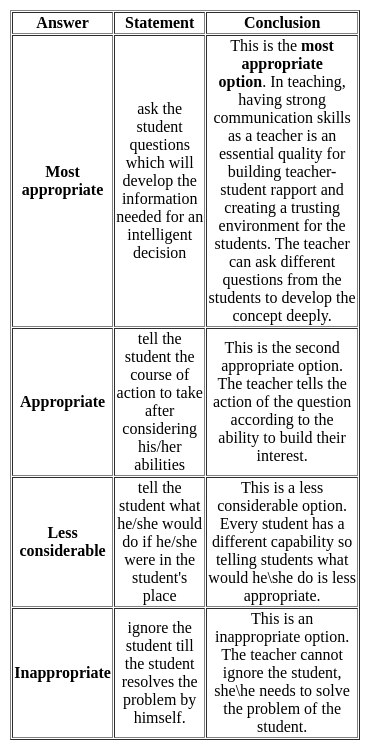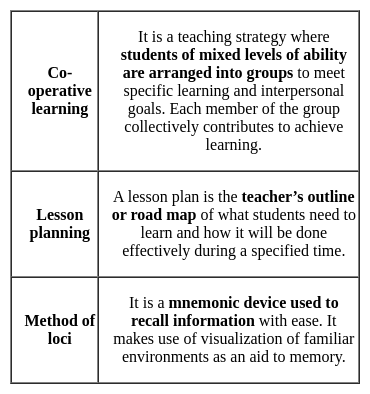Software Development Exam > Software Development Tests > Test: Teaching Aptitude (Factors Affecting Teaching) - Software Development MCQ
Test: Teaching Aptitude (Factors Affecting Teaching) - Software Development MCQ
Test Description
10 Questions MCQ Test - Test: Teaching Aptitude (Factors Affecting Teaching)
Test: Teaching Aptitude (Factors Affecting Teaching) for Software Development 2025 is part of Software Development preparation. The Test: Teaching Aptitude (Factors Affecting Teaching) questions and answers have been prepared
according to the Software Development exam syllabus.The Test: Teaching Aptitude (Factors Affecting Teaching) MCQs are made for Software Development 2025 Exam.
Find important definitions, questions, notes, meanings, examples, exercises, MCQs and online tests for Test: Teaching Aptitude (Factors Affecting Teaching) below.
Solutions of Test: Teaching Aptitude (Factors Affecting Teaching) questions in English are available as part of our course for Software Development & Test: Teaching Aptitude (Factors Affecting Teaching) solutions in
Hindi for Software Development course.
Download more important topics, notes, lectures and mock test series for Software Development Exam by signing up for free. Attempt Test: Teaching Aptitude (Factors Affecting Teaching) | 10 questions in 10 minutes | Mock test for Software Development preparation | Free important questions MCQ to study for Software Development Exam | Download free PDF with solutions
Test: Teaching Aptitude (Factors Affecting Teaching) - Question 1
A student has a problem. He/She asks the teacher "What shall I do ?" The teacher should
Detailed Solution for Test: Teaching Aptitude (Factors Affecting Teaching) - Question 1
Test: Teaching Aptitude (Factors Affecting Teaching) - Question 2
A teacher can be instrumental in protecting the Rights of the Child in the school. One of the important role of teacher according to RTE is
Detailed Solution for Test: Teaching Aptitude (Factors Affecting Teaching) - Question 2
Test: Teaching Aptitude (Factors Affecting Teaching) - Question 3
A teacher believes that each child is unique and a special individual, and therefore actively involves them in their own education and development. The teacher is adopting:
Detailed Solution for Test: Teaching Aptitude (Factors Affecting Teaching) - Question 3
Test: Teaching Aptitude (Factors Affecting Teaching) - Question 4
A creative learner refers to one who is
Detailed Solution for Test: Teaching Aptitude (Factors Affecting Teaching) - Question 4
Test: Teaching Aptitude (Factors Affecting Teaching) - Question 5
The learner’s purpose of learning is the most significant factor in a learning process because:
Detailed Solution for Test: Teaching Aptitude (Factors Affecting Teaching) - Question 5
Test: Teaching Aptitude (Factors Affecting Teaching) - Question 6
Aarav insists on sitting too close to the blackboard, and holds the book very close to his eyes while reading. What should a teacher do for Aarav in such a case ?
Detailed Solution for Test: Teaching Aptitude (Factors Affecting Teaching) - Question 6
Test: Teaching Aptitude (Factors Affecting Teaching) - Question 7
What instructional adaptations should a teacher make while working with students who are ‘Visually Challenged’?
Detailed Solution for Test: Teaching Aptitude (Factors Affecting Teaching) - Question 7
Test: Teaching Aptitude (Factors Affecting Teaching) - Question 8
In order to create a conducive learning environment, it is important to
Detailed Solution for Test: Teaching Aptitude (Factors Affecting Teaching) - Question 8
Test: Teaching Aptitude (Factors Affecting Teaching) - Question 9
Methods used to organize classroom activities and instruction, creating a happy and productive learning environment are known as
Detailed Solution for Test: Teaching Aptitude (Factors Affecting Teaching) - Question 9
Test: Teaching Aptitude (Factors Affecting Teaching) - Question 10
__________ ensures the use of alternative resources to facilitate instructions for teaching wherever there is a lack or specific firsthand teaching aids.
Detailed Solution for Test: Teaching Aptitude (Factors Affecting Teaching) - Question 10
Information about Test: Teaching Aptitude (Factors Affecting Teaching) Page
In this test you can find the Exam questions for Test: Teaching Aptitude (Factors Affecting Teaching) solved & explained in the simplest way possible.
Besides giving Questions and answers for Test: Teaching Aptitude (Factors Affecting Teaching), EduRev gives you an ample number of Online tests for practice
Download as PDF





















